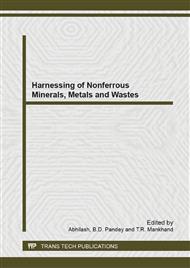p.11
p.21
p.33
p.45
p.55
p.65
p.73
p.81
p.93
Arsenic Removal from Spent Liquor Generated during Processing of Vanadium Sludge
Abstract:
During production of ammonium meta-vanadate from vanadium sludge an arsenic containing (~2.2g/L) spent liquor is generated. Safe disposal of such liquor without arsenic contamination to the environment is essential. Therefore, various methods such as ion-exchange, adsorption, solvent extraction and precipitation were applied for recovery of arsenic from the spent liquor. Based on the Eh-pH diagram of As-H2O, the arsenic based species were delineated. For ion exchange Lewatit FO 36 and Amberlite IRA 400 Cl- resins were used to extract arsenic from the spent liquor. With Lewatit FO 36 a maximum of 20% arsenic was recovered at A/R ratio of 50. Amberlite IRA 400 Cl- on the other hand didnt extract arsenic at all. A two stage solvent extraction process using TBP as an extractant, with a recovery of 97% arsenic from the spent liquor was developed. From the loaded TBP almost complete stripping of arsenic was obtained with 0.1-0.5M NaOH solution. Precipitation of arsenic from the spent liquor as copper arsenate or iron arsenate was also examined. During the fixation of arsenic with iron, 70% arsenic was recovered in the precipitate. This process needs to be evaluated further with the aim of using the iron hydroxide containing arsenic for different applications.
Info:
Periodical:
Pages:
55-63
Citation:
Online since:
November 2013
Authors:
Keywords:
Price:
Сopyright:
© 2014 Trans Tech Publications Ltd. All Rights Reserved
Share:
Citation:


